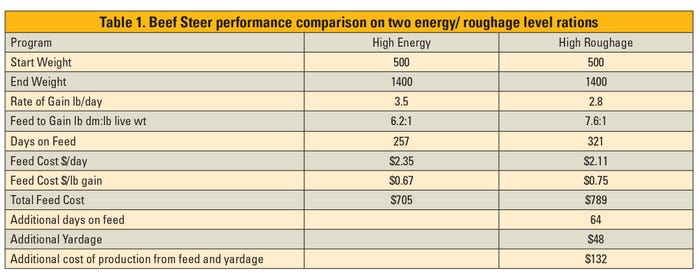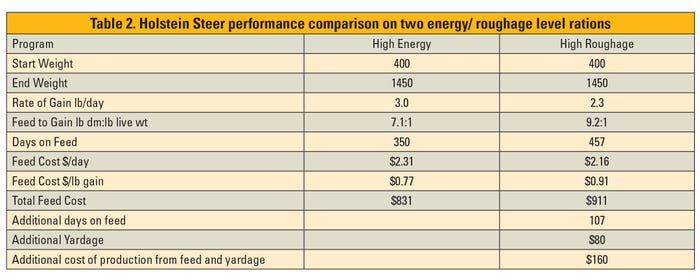October 20, 2021

When corn prices are high, it is common to hear some cattle feeders make the statement that they will have to cut back on the amount of corn and put more roughage in the ration to save money. There is a good chance that this practice may only be providing a false sense of saving money.
It is certainly a good idea to look at different feedstuffs for use in rations. When doing so, it is equally important to look at how the animals will perform on different rations to get an accurate picture of all the potential costs, and ultimately net returns, associated with a different ration.
When reducing the amount of grain or concentrate in feeds and increasing roughage, the energy level of the feed is usually reduced. This strategy leads to lower rates of gain, increased pounds of feed to produce a pound of gain, and more days on feed.
The following examples compare two rations, using the same feedstuffs but at different levels, to feed Holstein steers from 400 to 1,450 pounds and beef steers from 500 to 1,400 pounds. The example rations were formulated using the Beef Ration and Nutrition Decisions Software (BRaNDS) from Iowa State University, which uses the latest National Research Council Nutrient Requirements to predict animal performance. The University of Wisconsin Extension Feedlot Enterprise Budget spreadsheet was used to calculate costs used in the examples. Fall 2021 feed prices were used.
Example Rations (dry-matter basis)
High Roughage (30% roughage)
0.54 NEg Mcal/lb. dry matter
47% rolled corn
30% low-quality hay
20% dried distillers grains with solubles
3% mineral pack
High Energy (10% roughage)
0.62 NEg Mcal/lb. dry matter
67% rolled corn
10% low quality hay
20% dried distillers grains with solubles
3% mineral pack
The examples below both show that the cost of feed per head per day is higher for the higher-energy, lower-roughage ration. However, it is more important to look at the feed cost per pound of gain and the number of days on feed to help evaluate all costs associated with the ration change. Because the animals are gaining faster and more efficiently on the higher-energy ration, their total feed cost and yardage costs are less than on the lower-energy, higher-roughage ration.

 Even in the example of beef steers, where the differences are not as great on a daily basis, it does not take much for the total difference in cost to become substantial. Remember, every additional day on feed has costs beyond feed that are often forgotten about or overlooked. There is the equipment used to feed, bed and clean pens, plus labor, fuel and utilities, to name a few.
Even in the example of beef steers, where the differences are not as great on a daily basis, it does not take much for the total difference in cost to become substantial. Remember, every additional day on feed has costs beyond feed that are often forgotten about or overlooked. There is the equipment used to feed, bed and clean pens, plus labor, fuel and utilities, to name a few.Higher-forage rations can have a place in cattle feeding operations. Forages may be best used earlier in the feeding program as a grower-type ration, when cattle are more feed-efficient, and may fit well with some farms’ resources that grow forages as part of their conservation plans. Still, cattle should be transitioned onto finishing rations before they get too big to produce a desirable finished animal. Sometimes it may also be more profitable to sell the animals before transitioning them onto finishing rations rather than owning them through the finishing period.
It is time well spent to evaluate different rations and scenarios as prices and situations change to optimize profits using the resources the farm has available. When doing so, it is critical to look at all costs impacted by any ration changes, not just ration cost per ton or feed cost per day, to assess costs and returns accurately.
Halfman is the Extension agriculture agent in Monroe County, Wis. This column is provided by the University of Wisconsin Division of Extension Livestock Team.
About the Author(s)
You May Also Like




